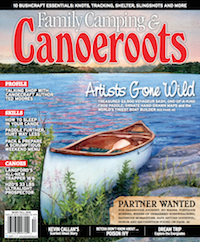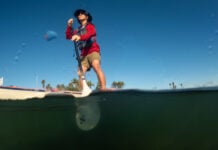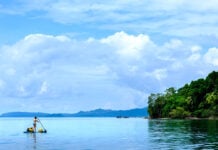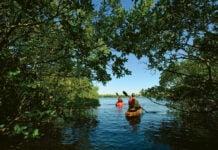Located on the extreme southern end of the Florida peninsula, Everglades National Park is a unique combination of fresh- water marshes, coastal prairies and mangrove swamps. During the summer, the heat and mosquitoes are intolerable, but in the drier and more temperate winter months, the park is a popular paddling and camping destination.
In the Everglades, the water and sky dominate as canoeists navigate across open gulf waters and around coastal mangrove islands, or paddle through endless dark narrow creeks. You can lose yourself in the beauty of the Everglades, but consult a map often as there are few distinct landmarks.
For campers, the national park offers unique chickees, elevated wooden platforms built on the water for tenting. Enjoy the solitude of being surrounded by water as you listen to the night noises of the remote wilderness. Sandy beach camping—complete with amazing sunsets—is also available. For the bold, there are ground sites in the dense backcountry forest, located where homesteaders lived decades ago and where the remnants of their farms remain.
TRIPS
If you have a half-day paddle out of the Flamingo Visitors Center into Florida Bay. Head east along the shoreline toward Snake Bight and watch hundreds of wading birds on the large mud flats during low tide. If you’re lucky, you may see an American flamingo or two. Bring fishing gear.
If you have a day paddle the outgoing tide from Gulf Coast Visitors Center to the gulf through Sandfly Pass. Have lunch on an island beach and catch the incoming tide on Indian Key Pass. Watch dolphins feeding in shallow waters, osprey in their nests, mullet jumping out of the water, and flocks of white pelicans soaring above.
If you have a weekend get a camping permit and launch from the Gulf Coast Visitors Center. Paddle across Chokoloskee and spend a night on one of the beach island campsites, such as Pavilion Key. Explore the beach and view the fiddler and horseshoe crabs and watch pelicans dive offshore as the sun sets over the open water.
If you have a week take a trip that includes chickee, ground site and beach camping. Begin and end your trip on the southern end near Flamingo Visitors Center or on the northern end at Gulf Coast Visitors Center. In a week’s time, you can truly experience the diversity of the Everglades, from open gulf waters to intimate mangrove creeks.

STATS
Average winter high: High 77 degrees Fahrenheit, Low 53 degrees Fahrenheit
Rain fall: 60 inches per year; rainy season is May to September
Wildlife: Alligator, crocodile, dolphin, manatee, horseshoe crab, great blue heron, osprey, white pelican, flamingo
Campsites: Select between ground sites, beach sites and elevated camping platforms, known as chickees.
Outfitters: Join a day trip or rent your own boat at Everglades Area Tours (www.evergladesareatours.com) or Everglades Adventures (www.evergladesadventures.com)
Diversion: The 15-mile Shark Valley paved trail overlooks the Everglades, providing a bird’s eye view of the park. Roadside attractions include boat rides and alligator farms.
Best eats: Havana Café on Chokoloskee Island. Try one of their Cuban sandwiches and a café con leche.
Must-have: Bug repellent, sun screen, map and tide schedule.
Constance Mier is a nature photographer who is inspired by her canoe explorations of the Everglades. Living in Miami, Florida, she can easily access the national park and spend days at a time exploring. Her photographs offer a glimpse of this beautiful wilderness area as seen from a canoe.
This article first appeared in the Fall 2015 issue of Canoeroots Magazine.
Subscribe to Paddling Magazine and get 25 years of digital magazine archives including our legacy titles: Rapid, Adventure Kayak and Canoeroots.











